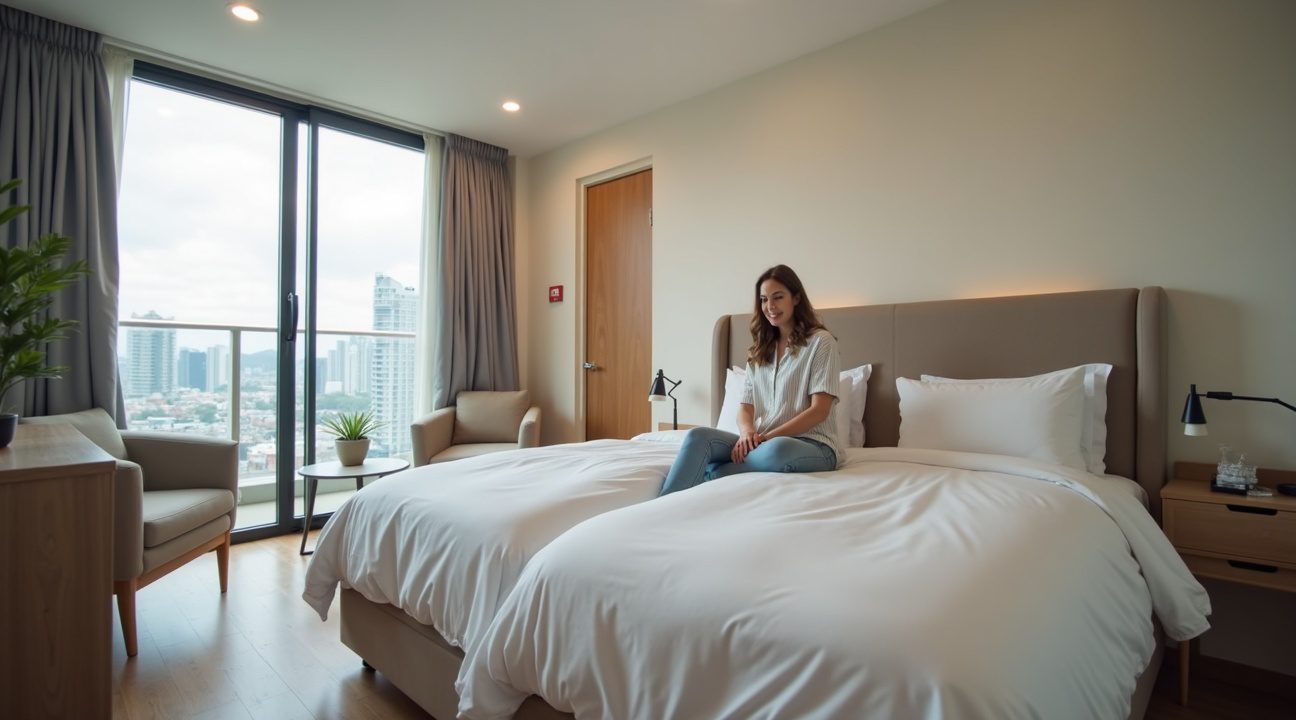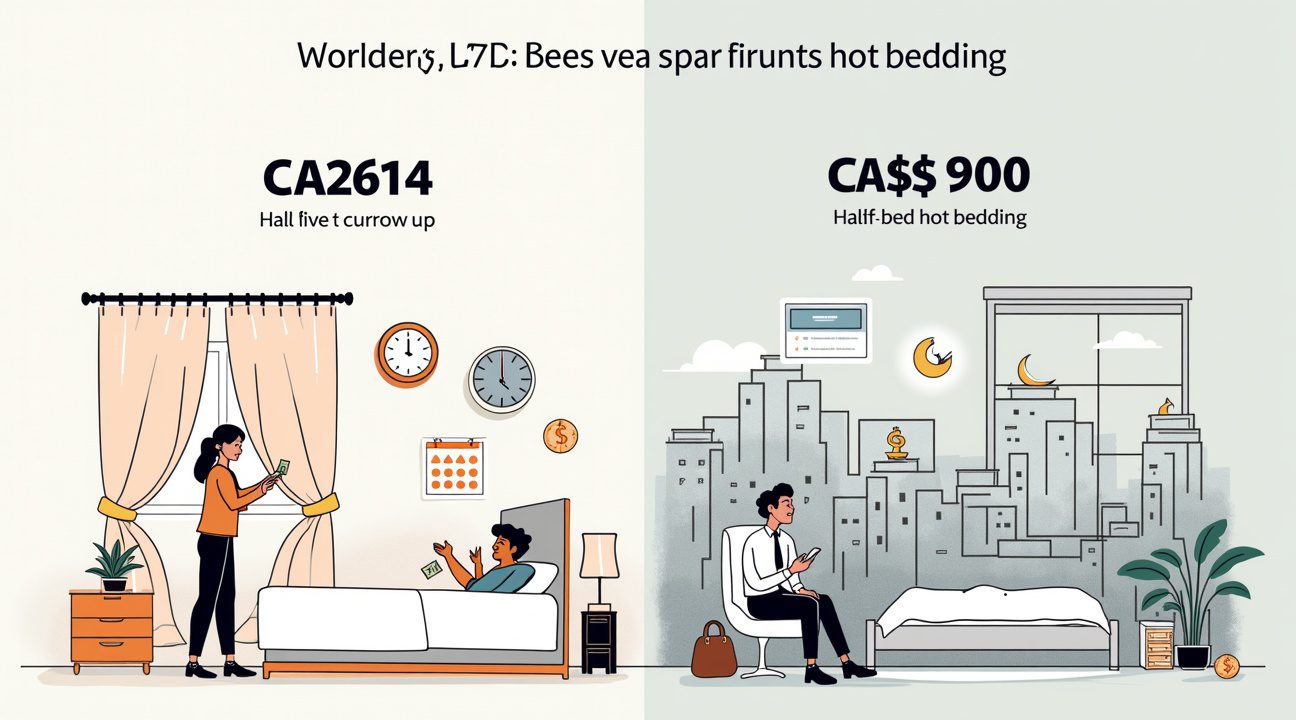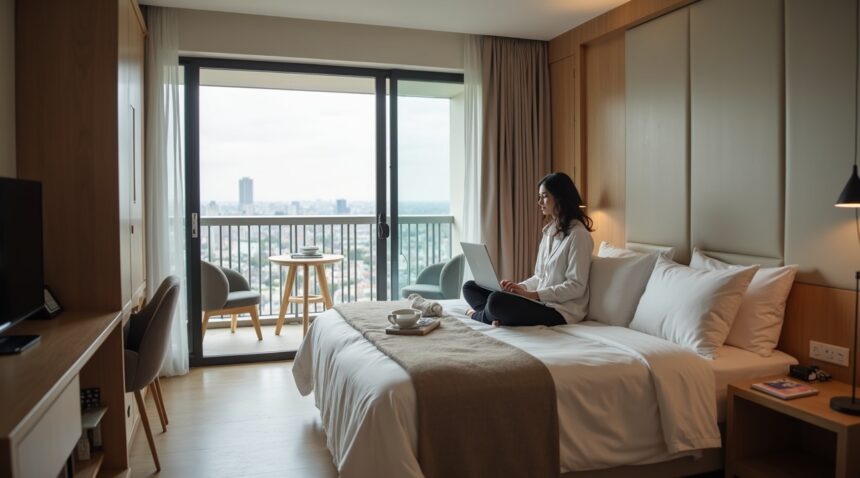Hot Bedding: An Unconventional Solution to Modern Housing Costs
Monique Jeremiah, a 36-year-old Australian woman, has creatively turned her queen-sized bed into a steady revenue stream by renting out one half for nearly £500 per month.
This unique concept, known as “hot bedding,” not only provides essential amenities like access to a bathroom, television, and private balcony, but also delivers both financial perks and companionship to hosts like Jeremiah. In an ever-challenging rental market, this model is gaining traction around the globe.
Key Takeaways
- Substantial Monthly Income: Hot bedding can yield as much as £500 in Australia and up to CA$900 in Canada’s competitive rental scenes.
- Emphasis on Safety: Background checks, written agreements, and non-sexual interaction policies are key to safe, respectful arrangements.
- Affordable Housing Alternative: Hot bedding appeals to students, young professionals, and travelers who value cost savings over privacy.
- Response to Soaring Rents: With one-bedroom apartments in Toronto surpassing $2,600 monthly, alternative solutions like hot bedding are becoming attractive.
- Compatibility Matters: Shared bed arrangements require aligned sleep schedules, communication skills, and mutual respect for long-term success.
How Jeremiah Screens and Sets Boundaries
Jeremiah’s method for selecting compatible bed-sharing partners is meticulous. Through in-depth conversations about lifestyle, work habits, and individual boundaries, she ensures alignment before any rental commitment is made. Thorough screening fosters a comfortable, sustainable living arrangement.
Global Trends in Hot Bedding
The rise in hot bedding is not limited to Australia. Cities such as Toronto, London, and Sydney are seeing a growing number of people turning to these arrangements due to pervasive affordability issues. For renters facing short-term accommodation needs or simply trying to make ends meet, hot bedding presents an immediate option.
Ensuring Safety and Upholding Standards
- Background Checks: Every potential guest undergoes a verification process to ensure they pose no risk.
- Written Agreements: Clear contractual documents detail expectations and responsibilities.
- Defined Conduct Guidelines: Non-sexual and cleanliness rules help preserve a respectful environment.
Expanding Financial Benefits
For hosts like Jeremiah, earnings from bed sharing extend beyond base rent. Utilities are frequently divided, and some hosts report saving 40-60% on total housing costs. These extra funds can be channeled toward debt repayment or future goals, boosting financial stability.
Who Is Embracing Bed-Sharing?
The demographic profile for hot bedding participants typically includes:
- Young professionals launching their careers while managing high living expenses.
- International students seeking affordable accommodations in expensive markets.
- Budget-conscious solo travelers looking to economize during extended stays.
For many, the arrangement is a transitional step as they work toward financial independence or seek permanent living solutions.
Compatibility and Communication Are Key
Succeeding in a bed-sharing setup requires more than just affordability. Shared expectations on cleanliness, matching sleep rhythms, and compatible communication styles lay the foundation for mutually beneficial arrangements. Trial periods further help both parties assess long-term potential.
Why Demand Is Rising
Across major cities, traditional housing options are rapidly becoming financially inaccessible. Rents often exceed $2,000 to $3,000 USD monthly in metropolitan areas, prompting renters to explore alternatives. Hot bedding offers an alternative that is both immediate and cost-efficient.
The Role of Location
Urban areas near colleges or corporate hubs, with easy access to transport, increase hot bedding’s viability. Safety features such as well-lit neighborhoods and secure entry further enhance a host’s appeal to applicants.
Technology’s Contribution
- Apps and platforms: Specialized sites offer reviews, verification tools, and secure payments.
- Trust-building tools: Matchmaking algorithms help connect compatible roommates and increase safety.
Legal and Psychological Considerations
Local laws and landlord policies can influence the legality of hot bedding. In some regions, it may be classified as a sublet and require permission or registration. Due diligence protects all parties from legal or lease violations.
Psychologically, not everyone is suited for this model. Some adapt well; others may struggle with reduced privacy. However, Jeremiah shares that many of these relationships blossom into lasting friendships with mutual social benefits.
A Creative Response to a Global Housing Crisis
Hot bedding exemplifies the innovative spirit individuals are adopting in response to rising living costs. With thorough screening, honest dialogue, and mutual respect, this unique arrangement can serve as both a financial lifeline and a bridge to deeper social connections.
How Monique Jeremiah Earns Nearly £500 Monthly From Her Queen-Sized Bed
Monique Jeremiah has turned her sleeping arrangement into a profitable side hustle that generates nearly £500 (AUD$985) monthly. The 36-year-old Australian woman rents out the other half of her queen-sized bed to strangers, creating an unconventional rental model that’s both financially rewarding and socially enriching.
The Practical Setup and Boundaries
Jeremiah’s bed-sharing arrangement operates under strict non-sexual guidelines that prioritize respect and privacy for both parties. Each person maintains their own side of the bed with clear boundaries that protect personal space and comfort. This respectful approach ensures that guests understand the platonic nature of the arrangement from the start.
The rental package extends beyond simple bed access, offering guests additional amenities that enhance their experience. Tenants gain access to:
- A double bathroom
- Television
- Private balcony
- Dedicated sitting area
These extra features transform the arrangement from basic bed sharing into a more comprehensive living experience that justifies the monthly rate.
Financial and Social Benefits
Income supplementation drives Jeremiah’s primary motivation for this unique rental strategy. The monthly earnings help her manage living expenses while maximizing the utility of her existing space. This approach allows her to generate revenue without investing in additional property or making significant modifications to her current setup.
Beyond financial gains, companionship and social interaction play crucial roles in Jeremiah’s decision to share her bed. Living alone can feel isolating, and this arrangement provides regular human contact and conversation opportunities. Many people today struggle with loneliness, making this social connection particularly valuable.
The practice falls under several categories that describe modern sharing economy trends. Hot bedding represents the most direct term for this arrangement, while bed sharing encompasses the broader concept of splitting sleeping spaces. These terms align with the growing trend of unconventional rental strategies that help people save money on accommodation costs.
Jeremiah’s success demonstrates how creative thinking can transform everyday situations into income opportunities. Her approach requires minimal startup costs since she’s utilizing existing furniture and space. The key lies in setting clear expectations and maintaining professional boundaries throughout the arrangement.
Safety considerations remain paramount in any bed-sharing scenario. Jeremiah likely implements screening processes to ensure compatible matches and reduce potential risks. These may include:
- Background checks
- References from previous hosts or landlords
- Initial meetings to establish rapport and expectations
This unconventional rental model appeals to various demographics, including budget-conscious travelers, temporary workers, and individuals seeking affordable accommodation in expensive cities. Young professionals, solo travelers, and people between permanent housing situations might find this option particularly attractive.
The arrangement works best when both parties share similar sleep schedules and habits. Compatibility in areas like bedtime routines, wake-up times, and cleanliness standards helps prevent conflicts and ensures positive experiences for everyone involved.
Jeremiah’s model represents a growing trend in alternative accommodation that challenges traditional rental concepts. As housing costs continue rising globally, creative solutions like bed sharing offer practical alternatives for both property owners and renters seeking affordable options.

Understanding the Hot Bedding Phenomenon
Hot bedding represents a radical shift in how people approach shared living arrangements and income generation. This practice involves renting out half of one’s bed to strangers, creating an unconventional roommate situation that challenges traditional housing norms.
What Drives the Hot Bedding Trend
The rise of hot bedding stems directly from escalating rental costs in major cities. When studio apartments command premium prices and traditional room shares remain out of reach, innovative solutions emerge. Hot bedding offers a dual benefit: renters can slash their housing expenses while property owners generate additional income from their existing space.
This arrangement particularly appeals to individuals who prioritize intellectual connections over physical relationships, especially sapiosexuals who value mental stimulation above conventional romantic dynamics. The practice creates opportunities for meaningful conversations and shared experiences without the complications of traditional dating or roommate arrangements.
How Hot Bedding Functions in Practice
Hot bedding operates on a simple principle of space optimization and mutual benefit. Participants typically establish clear boundaries and schedules to ensure comfort and privacy for both parties. Some arrangements involve alternating sleep schedules, while others feature larger beds that accommodate simultaneous occupancy with agreed-upon boundaries.
Several factors contribute to the growing acceptance of this phenomenon:
- Rising rental costs forcing creative housing solutions
- Increased social acceptance of non-traditional living arrangements
- Growing emphasis on financial flexibility and alternative income streams
- Changing attitudes about personal space and privacy
- The influence of sharing economy principles on housing
The practice challenges conventional notions of personal space while addressing practical financial concerns. For solo travelers and young professionals, hot bedding provides an affordable entry point into expensive housing markets.
Success in hot bedding arrangements depends heavily on clear communication and compatible personalities. Participants often establish detailed agreements covering sleep schedules, personal hygiene standards, and guest policies. The emphasis on intellectual compatibility means many hot bedding partnerships develop into lasting friendships built on shared interests and mutual respect.
This phenomenon reflects broader changes in how society views privacy, intimacy, and financial necessity. As housing costs continue rising, alternative arrangements like hot bedding may become increasingly common, particularly among younger demographics comfortable with unconventional living situations.
Hot bedding represents more than just a housing hack—it embodies a pragmatic response to economic pressures while fostering human connections in an increasingly isolated world.

Financial Comparison: Hot Bedding vs Traditional Housing
Monique Jeremiah’s monthly earnings of approximately £500 through hot bedding reveal the stark financial advantages this unconventional arrangement offers both hosts and renters. Converting to other currencies, she generates roughly AUD$985 or USD$600 each month simply by sharing her sleeping space with strangers.
The economics become even more compelling when comparing hot bedding rates against traditional rental markets in crisis-hit cities. Toronto serves as a prime example of how desperate housing shortages drive innovative solutions. Half-bed arrangements in Toronto now command CA$900 per month, exceeding £520 – actually more than what Jeremiah charges for her entire side of the bed. This pricing reflects the severe accommodation shortage plaguing major urban centers.
Cost Breakdown Against Traditional Rentals
Traditional housing costs in cities like Toronto paint a sobering picture for budget-conscious renters. The average one-bedroom rental reaches $2,614 per month, creating an enormous financial burden that forces people to consider alternative living arrangements. Hot bedding suddenly appears as a viable solution when faced with such astronomical housing costs.
For renters seeking hidden ways to save money, hot bedding represents significant monthly savings. Someone paying CA$900 for half a bed in Toronto still saves over $1,700 compared to securing their own one-bedroom apartment. These savings can fund other life goals, from travel adventures to building emergency funds.
The financial appeal extends beyond mere cost reduction. Hosts like Jeremiah create passive income streams without major property investments or lengthy tenant screening processes. She earns £500 monthly from space that would otherwise remain unused, transforming a basic necessity into a revenue generator.
However, the financial benefits come with important trade-offs that potential participants must carefully consider:
- Privacy: Sharing a bed with strangers naturally limits personal space and disrupts traditional bedtime routines.
- Risk: Sleep quality, personal safety, and lifestyle compatibility are critical concerns, often lacking the stability of traditional rental agreements.
- Legality: Lack of formal contracts or housing protection laws for hot bedding participants can introduce legal ambiguities.
Companionship emerges as an unexpected benefit that some find valuable enough to offset privacy concerns. Travelers and digital nomads often appreciate the built-in social connection, especially when staying in unfamiliar cities. This human element can provide safety, local knowledge, and friendship opportunities that traditional accommodations lack.
The demographics drawn to hot bedding typically include young professionals, students, and transient workers who prioritize financial savings over conventional living standards. Solo female travelers sometimes find comfort in shared sleeping arrangements, particularly in cities where safety concerns make traditional budget accommodations less appealing.
Risk assessment becomes crucial when evaluating hot bedding against traditional housing options. While hosts like Jeremiah can screen potential bed-sharers, the arrangement inherently involves greater personal risk than standard rental relationships.
Market demand continues growing as housing affordability reaches crisis levels in major cities worldwide. Young adults facing stagnant wages and skyrocketing rents increasingly view hot bedding as a practical rather than desperate measure. This shift in perception helps normalize arrangements that previous generations might have considered unthinkable.
The success of hot bedding also depends heavily on location and local regulations. Urban centers with severe housing shortages and high concentrations of transient populations create ideal conditions for these arrangements. Suburban or rural areas typically lack both the demand and the cultural acceptance necessary for hot bedding to thrive financially.
Insurance and legal considerations add complexity to the financial equation. Traditional renters enjoy tenant protections and clear legal frameworks, while hot bedding participants often operate in gray areas without formal agreements or legal recourse. These factors can create hidden costs or financial risks that offset some of the apparent savings.
For individuals like Jeremiah, hot bedding represents financial empowerment through creative resource utilization. She’s transformed a basic living space into an income-generating asset while simultaneously addressing urban housing shortages. This model demonstrates how economic pressures can spark innovative solutions that benefit multiple parties despite unconventional arrangements.

Who Hot Bedding Appeals To and Safety Considerations
The Ideal Hot Bedding Participant
Hot bedding attracts a specific type of person who prioritizes practicality over conventional privacy expectations. People who thrive in this arrangement typically possess strong emotional boundaries and can compartmentalize their personal space effectively. These individuals view their sleeping arrangements through a business lens rather than an intimate one.
The arrangement appeals most to socially confident people who don’t require complete solitude to feel comfortable. Many participants are young professionals, students, or solo travelers who value companionship and cost-effectiveness over traditional privacy norms. Open-minded individuals who adapt easily to unconventional situations often find hot bedding surprisingly manageable.
Successful hot bedding participants share several key characteristics:
- Strong communication skills and boundary-setting abilities
- Comfort with shared intimate spaces without romantic implications
- Ability to treat the arrangement as a straightforward business transaction
- Respectful nature and understanding of personal space within shared limits
- Emotional maturity to handle potential awkward moments or conflicts
- Flexibility in sleep schedules and personal routines
People seeking alternative ways to save money often discover hot bedding as an unexpected solution to housing costs. The arrangement particularly attracts individuals who prioritize experiences and financial freedom over material comforts.
Essential Safety Measures and Boundary Setting
Safety considerations form the foundation of any successful hot bedding arrangement. Participants must establish comprehensive vetting processes before allowing strangers into their most vulnerable space. Background checks, reference verification, and thorough interviews help identify suitable partners for this unique living situation.
Clear communication protocols prevent misunderstandings and create mutual respect. Establishing explicit rules about personal belongings, sleep schedules, and acceptable behavior ensures both parties feel secure. Many successful hot bedding hosts create written agreements outlining expectations, emergency procedures, and grounds for immediate termination of the arrangement.
Physical safety measures include secure locks on bedroom doors, emergency contact sharing, and check-in protocols with trusted friends or family members. Installing security cameras in common areas (never in bedrooms) provides additional peace of mind for both participants. Some hosts require guests to provide identification and emergency contact information before the first night.
Personal boundaries require constant attention and adjustment. Participants should discuss comfort levels regarding personal items, clothing choices, and overnight guests. Creating designated spaces for personal belongings prevents conflicts and maintains individual privacy within the shared arrangement.
Trust-building happens gradually through consistent respectful behavior and open dialogue. Regular check-ins allow both parties to address concerns before they escalate into serious problems. Traveling companions often develop similar trust through shared experiences, though hot bedding requires even greater intimacy tolerance.
Emergency preparedness includes having backup accommodation options and clear exit strategies for both parties. Participants should maintain separate support networks and never become financially dependent on the arrangement. Professional mediation services can help resolve conflicts that arise during extended hot bedding relationships.
Financial transparency protects both parties from exploitation or misunderstandings. Clear payment schedules, utility responsibilities, and additional fee structures prevent money-related disputes. Some hosts require security deposits or advance payments to ensure commitment and cover potential damages.
The arrangement works best when both participants maintain independent social lives and personal interests. Avoiding emotional dependency preserves the business-like nature that makes hot bedding sustainable long-term. Regular evaluation of the arrangement ensures it continues meeting both parties’ needs without compromising safety or comfort.
Risks and Practical Considerations of Sharing Your Bed
Hot bedding arrangements present significant privacy challenges that extend beyond typical roommate situations. I’ve observed that sharing such intimate space requires careful consideration of personal boundaries and comfort levels. Privacy becomes virtually non-existent when strangers occupy the same sleeping surface, making this arrangement unsuitable for those who value personal space during rest periods.
Safety concerns represent the most critical aspect of bed-sharing with strangers. Physical vulnerability increases dramatically when sleeping inches away from unknown individuals. I recommend thorough background checks, verified references, and initial meetings in public spaces before agreeing to any arrangement. Installing security cameras in common areas (not bedrooms) and maintaining emergency contacts can provide additional safety layers.
Essential Boundaries and Compatibility Factors
Emotional maturity plays a decisive role in successful bed-sharing arrangements. Both participants must establish clear guidelines covering sleep schedules, personal belongings, hygiene standards, and overnight guests. I’ve found that discussing expectations upfront prevents most conflicts that arise in these unconventional living situations.
Consider these compatibility requirements before entering such arrangements:
- Similar sleep patterns and bedtime routines
- Mutual respect for personal space within shared areas
- Comparable cleanliness and hygiene standards
- Agreement on noise levels and electronic device usage
- Shared understanding about bringing romantic partners
Professional conduct becomes essential when sharing sleeping quarters with strangers. Setting boundaries around physical contact, personal conversations, and shared responsibilities helps maintain appropriate distance. I suggest creating written agreements that outline expectations, payment terms, and termination procedures to protect both parties legally.
Financial considerations extend beyond monthly payments. Additional costs might include upgraded bedding, storage solutions for personal items, and potential security deposits. Some hosts require renters’ insurance or additional cleaning fees, which can impact the overall affordability of these arrangements.
The arrangement’s success hinges on both participants’ ability to communicate openly about concerns and adjust boundaries as needed. Regular check-ins help identify potential issues before they escalate into serious problems. Many successful bed-sharing arrangements involve hidden ways to save money while maintaining respectful relationships between participants.
Exit strategies become crucial when arrangements don’t work as planned. Establishing clear termination procedures, including notice periods and refund policies, protects both hosts and renters from uncomfortable situations. I recommend maintaining alternative housing options and emergency funds in case immediate relocation becomes necessary.
Those considering bed-sharing arrangements should evaluate their personal comfort levels carefully. While financial benefits might seem attractive, the potential risks to privacy, safety, and emotional well-being require serious consideration before committing to such intimate living situations with strangers.

Global Hot Bedding Market and Housing Crisis Response
Hot bedding has emerged as a direct response to housing affordability crises that plague major cities across the globe. I’ve observed this trend gaining momentum as traditional rental markets become increasingly inaccessible to working professionals and students alike.
Market Economics Driving the Trend
Toronto’s housing market perfectly illustrates the extreme economic pressures fueling this phenomenon. Individuals now pay CA$900 monthly for half a bed space, while a standard one-bedroom apartment commands $2,614. This stark price difference makes bed-sharing arrangements financially attractive for those who can’t afford conventional housing options.
The math becomes compelling when people consider their alternatives. Rather than struggling with unaffordable rent or lengthy commutes from distant suburbs, they’re choosing proximity to employment centers and creative money-saving strategies that allow them to maintain their urban lifestyles.
Cultural Shifts and Social Adaptation
This practice reflects fundamental changes in how society approaches privacy and personal space. I’ve noticed that younger generations particularly embrace these arrangements, viewing them as practical solutions rather than uncomfortable compromises. Their willingness to adapt demonstrates remarkable flexibility in addressing housing challenges.
The trend also highlights evolving attitudes about alternative income generation. Property owners and renters alike recognize opportunities to monetize their existing resources more efficiently. This shift represents a broader movement where people actively seek innovative ways to make housing costs manageable while maintaining their desired locations.
Hot bedding exemplifies the creative problem-solving that emerges during housing crises. Cities worldwide face similar pressures, with travelers and residents adapting to economic realities through unconventional arrangements. These solutions often arise organically from necessity rather than policy initiatives.
The practice extends beyond simple cost-sharing arrangements. It represents a fundamental reimagining of how urban dwellers utilize space and resources. People increasingly prioritize location and financial sustainability over traditional notions of privacy and personal territory.
Housing shortages continue affecting metropolitan areas globally, creating environments where hot bedding thrives. I see this trend accelerating as property values outpace income growth, forcing individuals to explore alternatives that seemed unimaginable just decades ago. The willingness to share intimate spaces with strangers demonstrates how economic pressures reshape social boundaries and create new forms of urban living arrangements.

Sources:
LADBible: “Woman makes nearly £500 a month renting out the other side of her bed to strangers”
The Economic Times: “Toronto rent: CA$900 for half bed. Watch viral video, know everything about it”
YouTube: “Woman Makes $600/Month Renting Out the Other Side of Her Bed to Strangers”
YouTube: “I Make An Extra £500 A Month From Renting Half My Bed…”


